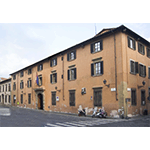Universitą degli Studi di Firenze - Rettorato [University of Florence - The Rectorate]
The General Studium was born with a resolution of the Commune of Florence in 1321. In 1324, after only three years of existence, it was forced to cease activity, which it resumed, however, in 1349, at its headquarters on today’s Via "dello Studio". In 1387, after another interruption, new statutes were promulgated: the first chair in Greek in Europe was instituted and greater impulse was given to medicine; the Commune of Florence offered two corpses for the lessons in anatomy. In 1473, with the reopening of the University of Pisa and the transfer of the General Studium to Pisa, the Florentine University retained only the Theology College which taught humanities. In 1497, it was enriched with the scientific chairs of the University of Pisa, which was temporarily transferred to Florence, where it remained until 1505. The first lessons in mathematics at the Florentine University were held by Luca Pacioli in 1500. In 1571, Egnazio Danti was summoned to fill the chair in mathematics and, in 1586, was succeeded by Ostilio Ricci who had the merit of having taught geometry to the young Galileo. In 1642, the chair in mathematics was filled by Evangelista Torricelli; at his death in 1647, he was succeeded by Vincenzo Viviani. During the last Medici grand duchy and the first Lorraine government, lectures in botany were held first by Pier Antonio Micheli and then, as of 1737, by Giovanni Targioni Tozzetti.
The diffusion of culture in Florence occurred through institutions parallel to the Studio until the years of the Unification of Italy when, in 1859 under the provisional government of Bettino Ricasoli, the Institute of Advanced Studies was created, which would later become today’s University. The Institute of Advanced Practical and Specialised Studies inherited and continued the activity of the Lyceum of Physical and Natural Sciences, taking its place in the great Florentine cultural tradition. The purposes of the Institute, as its name clearly indicated, was on one hand, specialisation for those who had already terminated their university studies and, on the other hand, pure scientific research. At the same time, the Institute proposed a coordination between scientific studies and humanistic studies. It was indeed composed of three sections: Medicine and Surgery, Natural Sciences, Philosophy and Philology. Initially, a section of Legal Sciences was also instituted, but it was short-lived. In 1872, the national parliament approved a convention that permitted its reorganisation and enlargement, increasingly more assuming the physiognomy of a university. Indeed, in the years that followed, the sections were configured as veritable faculties and, in 1923, the Institute transformed into the University of Florence. In November, 1924, the first academic year of the University of Florence was inaugurated.
Of the decorative apparatus of the University Rectorate in Piazza San Marco, let us point out the statue of Galileo Galilei.
****************************
Texts by Anna Toscano
English translation by Victor Beard
Last update 30/gen/2008




